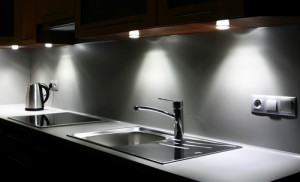 The kitchen is a room that feeds your hunger and your relationships with family and friends. When it’s time to update the kitchen, the changes must match your personal style.
The kitchen is a room that feeds your hunger and your relationships with family and friends. When it’s time to update the kitchen, the changes must match your personal style.
Because the kitchen pulls double duty – serving as a work space and a gathering spot – kitchen lighting is a vital component in creating the right atmosphere. There are three main categories of kitchen lighting to consider: ambient, task and accent. Here’s what you need to know about each to make the room fitting for your family.
Ambient lighting in the kitchen
Ambient lighting is the main light source. Updated kitchens often feature recessed lighting, but if you prefer track lighting or fixtures, there are a variety of style options.
A good rule for ambient lighting – specifically recessed lights – is to create illumination wherever your feet can travel in the kitchen. So, if you have a galley-style kitchen, a single row of recessed lights will likely offer sufficient illumination. If your kitchen is a large, open space, use a grid of lights rather than a single row.
Ensure the lights are spaced appropriately and that they don’t interfere with other light sources – like pendants. You’ll want to check the recommended spacing based on your ceiling height.
If recessed lighting isn’t an option or you just prefer the look of tracked lighting, go for a style that has a wide beam spread to avoid the spotlight look.
Task lighting in the kitchen
This light source is used for all the work you’ll be doing in the space, and is a crucial element to making your job in the kitchen easier and safer.
As kitchen countertops make up the majority of your work space, you should always install lighting under your cabinets. You don’t want a shadow interfering while you chop, grate or mix food. Under cabinet lighting illuminates your work area and improves the functionality of your kitchen.
Many styles can be easily installed on your existing cabinets or you can have the lights integrated into your entire kitchen lighting system.
Accent lighting in the kitchen
Accent lighting is where your personal flare is most obvious. This lighting is more about design and style than hard measurements. Accent lighting is often used above an island or your kitchen table.
You’ll want to be aware of the size of your accent lighting so you leave enough head space. A general rule of clearance is to leave 30 to 36 inches between the light fixture and the surface of your countertop or table.
Don’t be afraid to add a pop of color or bold pattern with your accent lighting. It’s the perfect opportunity to offer an unexpected piece of jewelry to the room.
Lighting controls in the kitchen
Traditional light switches will get the job done, but you can add character to your kitchen lighting with dimmers. Dimmers are especially handy in open floor plan spaces when you don’t want to interrupt other living spaces with a harsh, bright light.
